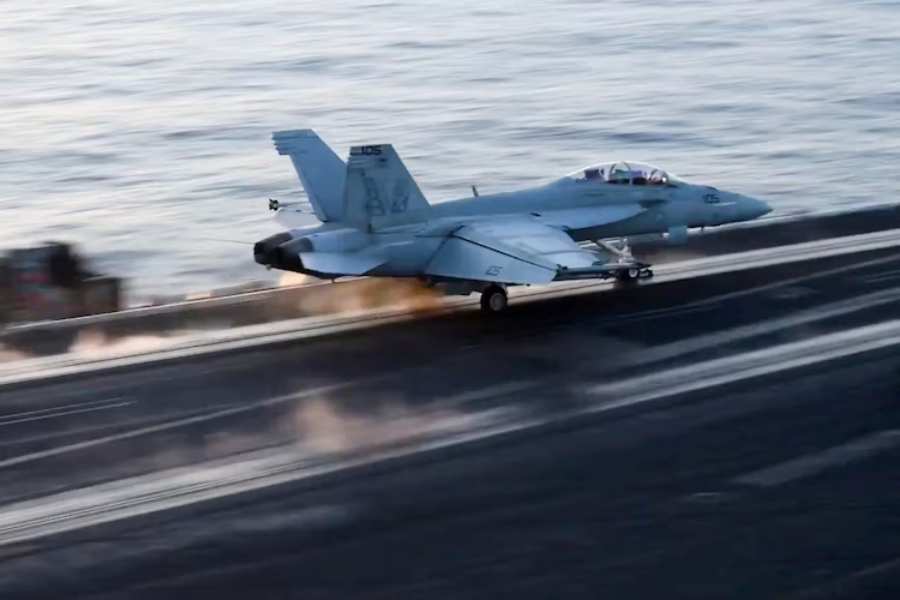LONDON – A missile and drone assault launched by Yemen’s Houthi rebels against U.S. Navy ships in the Red Sea has failed, with none of the projectiles reaching their intended targets, a U.S. official confirmed to ABC News. The attack comes in response to a new wave of U.S. airstrikes targeting the Iranian-backed militant group, marking an escalation in the ongoing conflict.
According to the Houthis, the group fired 18 ballistic missiles and a drone at the USS Harry S. Truman aircraft carrier group in two separate attacks within 24 hours. They claimed that the strike was a defensive measure to “thwart a hostile attack” allegedly being prepared by the United States against Yemen.
However, a U.S. official, speaking on condition of anonymity, stated that the actual numbers were significantly lower. The Houthis launched 11 drones and a single ballistic missile, none of which posed a direct threat to American vessels. The drones were intercepted by U.S. fighter jets—10 were shot down by Air Force planes and one by a Navy aircraft. The ballistic missile failed to reach its intended target, falling far short of the U.S. fleet, the official confirmed.
The failed strike was a direct response to a series of American air raids in Yemen that began on Saturday. President Donald Trump described the military action as “decisive and powerful,” emphasizing that the U.S. is committed to dismantling the Houthis’ military capabilities while warning of continued retaliation if attacks on U.S. and allied assets persist.
The Houthis, a militant faction backed by Iran, have intensified their activities in recent years, targeting Western-linked shipping in the Red Sea and launching missile strikes toward Israel since 2022. The group claims that these actions are meant to pressure Israel into lifting its blockade on Gaza amid the ongoing war with Hamas.
President Trump, in a statement posted on his social media platform Truth Social, accused the Houthis of conducting “an unrelenting campaign of piracy, violence, and terrorism” against U.S. and allied vessels. He warned that the United States would “use overwhelming lethal force until we have achieved our objective.”
According to U.S. military officials, American air and naval forces have carried out precision strikes against dozens of Houthi targets across Yemen, including missile stockpiles, radar installations, air defense systems, and drone launch sites. These attacks have been described as a direct warning to Iran, which has been accused of providing the Houthis with military equipment and tactical support. The strikes are intended to cripple the Houthis’ offensive capabilities and send a strong message to Tehran.
While the Pentagon has emphasized that the U.S. strikes were necessary to protect commercial and military assets in the region, some international observers have voiced concerns about the potential for further escalation. The region remains highly volatile, and any intensification of military action risks drawing in more actors.
Yemen’s Health Ministry reported that the U.S. airstrikes resulted in at least 53 deaths and 98 injuries, though these figures have not been independently verified. The extent of damage to Houthi infrastructure remains uncertain, but early assessments suggest that the strikes have significantly disrupted the group’s ability to launch future attacks.
Speaking to reporters aboard Air Force One, President Trump dismissed concerns over possible retaliatory strikes from the Houthis or Iran, asserting that the U.S. is fully prepared to respond to any threats. “They know what will happen if they continue down this path,” Trump stated.
Meanwhile, National Security Adviser Mike Waltz emphasized on ABC’s “This Week” that the U.S. military action was strategic and well-calculated. “This was an overwhelming response that targeted multiple Houthi leaders and took them out. The difference this time is that we are directly holding Iran accountable for its role in supporting these attacks,” Waltz explained.
Despite the failed attack, the Houthis remain defiant, vowing to continue targeting Western and Israeli-linked vessels. In a statement released on Sunday, the group declared that it will persist in blocking the passage of Israeli ships in the Red Sea until Israel lifts its blockade on Gaza.
Although the latest missile strike was unsuccessful, military analysts caution that the Houthis are likely to persist with their aggressive tactics. The group has demonstrated resilience in previous conflicts, adapting its military strategy in response to evolving threats. With Iran’s continued support, the Houthis possess the capability to refine their missile technology and launch more sophisticated attacks, potentially escalating the conflict further.
The failed Houthi missile strike highlights the increasing instability in the Red Sea, a critical route for global trade. The escalating hostilities have raised concerns over the safety of commercial shipping and the broader impact on international supply chains. The United States and its allies now face a challenging strategic decision—whether to intensify military action against the Houthis or seek diplomatic solutions to de-escalate tensions.
Some analysts argue that continued airstrikes could prolong the conflict and deepen regional instability, while others insist that a firm military response is the only way to deter further attacks. The Biden administration has indicated that it will maintain pressure on the Houthis, warning of further military action if the group continues its attacks. However, the situation remains fluid, and the next steps will have significant implications for the broader Middle East.
As the conflict unfolds, attention is focused on Yemen, Iran, and the United States—each playing a crucial role in a crisis that has the potential to spiral into a much larger regional confrontation. With tensions running high and no immediate resolution in sight, the world remains on edge, waiting to see what happens next.


